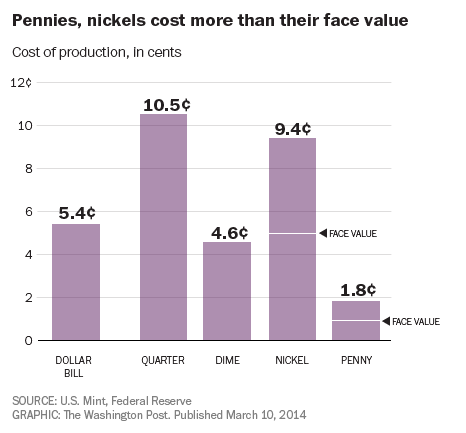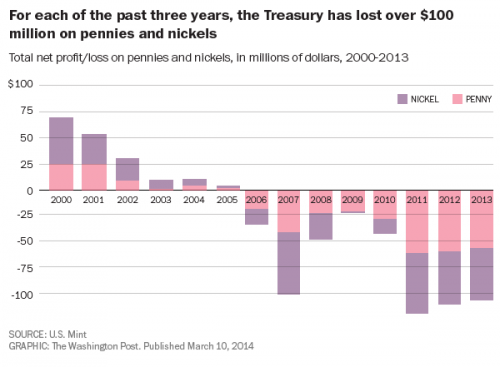We all know that, on some basic level, money is purely symbolic. It only works because everyone collectively agrees to participate in the fantasy that a dollar bill is worth a dollar, whatever that is. Moreover, most of our money these days is purely electronic, represented by ones and zeros and real only in the most abstract sense possible.
Christopher Ingraham at the Washington Post offered another way of thinking about money as a social construction: how much it costs to make it. None of our coins are actually worth what they cost, and pennies and nickels are worth quite a bit less.
The excess cost of producing pennies and nickels means a budget deficit for the Treasury. In 2013, producing the coins cost the government $105 million dollars above and beyond the coins’ value.
Interestingly, moves to eliminate pennies have been successfully opposed by the zinc industry for years, illustrating another sociological phenomenon: the power of corporations to shape government decisions.
Lisa Wade, PhD is an Associate Professor at Tulane University. She is the author of American Hookup, a book about college sexual culture; a textbook about gender; and a forthcoming introductory text: Terrible Magnificent Sociology. You can follow her on Twitter and Instagram.


Comments 11
Sheila Johnston — April 24, 2014
Here in Canada we got rid of the penny, through an act of Parliament last year. Cashiers either round up or down from the 5 cent mark. There is no difference in electronic transactions. I don't miss them at all.
Colin — April 25, 2014
You also have to take into account the lifespan of coins and banknotes, so they have to be produced not only to increase the supply of cash, but also to replace existing cash. Metal coins last for decades, but notes wear out quite quickly, so it would save money in the long run to switch from dollar bills to dollar coins. I gather that the cotton industry has played a role in promoting the dollar bill over the dollar coin for this reason. (I suspect the US dollar bill is currently the least valuable banknote in widespread circulation in a first-world country - typically, the lowest-value banknote in a first-world country nowadays is worth somewhere in the range $3-$10.)
Bill R — April 25, 2014
I throw pennies in the trash or leave them on the counter. Foolish little things to carry around with you...
Fuck yo couch — February 1, 2015
Thats why canada did away with pennies, we round up/down and use Plastic Bills you CANNOT tear, no matter how strong you are.
A Lesson On Sex & Gender for People Over 40 (Like Me) | Baby Dust Diaries — March 20, 2015
[…] because gender is a social construct doesn’t make it any less real.Money is a social construct too and people kill and die for it all the time. Should I say “money doesn’t exist” because it […]
In which I try to disillusion you – Discombobulated, I — July 23, 2016
[…] constructs which keep the societal model which makes them rich afloat. The essence of currency is fictive. The world is so far in debt it would be impossible to repay everyone. But we still use these two […]
paulstatchenrex — July 27, 2016
[…] Money as a Social Construction […]
Anna Fassbinder — December 1, 2019
Der Artikel enthält viele weise Gedanken. In der Tat war Geld schon immer ein wichtiger Faktor in der Gesellschaft, und Sie müssen sich damit abfinden. Es ist gut, dass mir https://online-roulett.at/bitcoin-casino/ die Möglichkeit gegeben hat, es zu realisieren. Egal was Sie entwickeln, es bringt Ihnen eine gute Versicherung in Form von finanzieller Unabhängigkeit
Kerry Smith — October 2, 2023
Hello! In the modern gambling industry there are many opportunities to earn fiat money and even cryptocurrency. However, not everyone is familiar with the possibility of passive income in gambling. I want to share with you the site https://tower.bet/about-decoy where you will find detailed information about earning money using the decoy token. I am sure that this information will be of great benefit to you, because with this token, earnings are guaranteed.